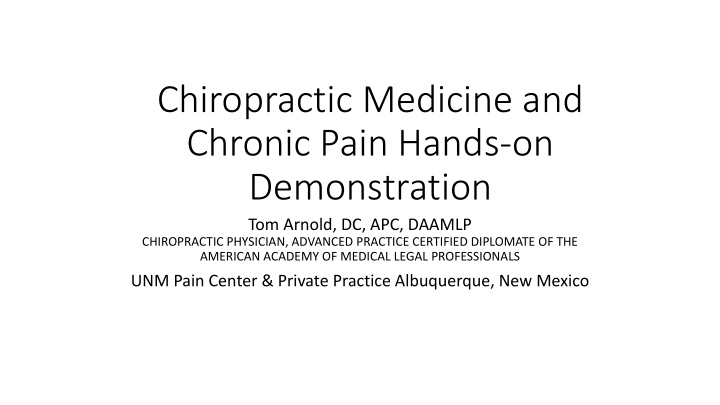



Chiropractic Medicine and Chronic Pain Hands-on Demonstration Tom Arnold, DC, APC, DAAMLP CHIROPRACTIC PHYSICIAN, ADVANCED PRACTICE CERTIFIED DIPLOMATE OF THE AMERICAN ACADEMY OF MEDICAL LEGAL PROFESSIONALS UNM Pain Center & Private Practice Albuquerque, New Mexico
No disclosures
Presentation Objectives At the conclusion of this presentation and hands-on demonstration of a few chiropractic treatment techniques to address spinal joint dysfunction/fixation, participants will be able to: •Recognize the complexity of manual and instrument chiropractic adjustment techniques •Describe the underlying theoretical mechanism of action…how chiropractic adjustment techniques activate spinal segmental stabilization •Integrate and/or recommend chiropractic referral relationships and co- management of acute and chronic musculoskeletal pain/function patterns
Spinal Joint Dysfunction: What is it? •Malposition •Misalignment •Subluxation (biomechanical vs. anatomical) •Nerve impingement •Bone out of place •Somatic joint dysfunction/fixation •Hypomobile joint •Loss of joint play •Etc.
Whatever it is and whatever you call it, it responds to manipulation/adjustment type procedures.
A Working Dynamic Model of Joint Dysfunction Panjabi offers a unique model of joint dysfunction: •disturbed kinematics (motion), •loss of spatial and temporal integrity of received receptor signals (input), •corrupted motor programs (output). Panjabi MM. A hypothesis of chronic back pain: ligament subfailure injuries lead to muscle control dysfunction. Eur Spine J , 2006;15(5):668-76.
A WORKING DYNAMIC MODEL OF SPINAL JOINT DYSFUNCTION Trauma and/or microtrauma cause subfailure injury (not a complete rupture) to ligamentous structures (i.e. joint capsules, discs, other ligaments of the motor unit).
Vertebral Intersegmental Motion Unit
This damages collagen fibers and destroys mechanoreceptors (MRs) embedded in injured passive ligamentous restraints.
Scanning electron micrograph of normal (left) and damaged (right) ligament.
There are 4 types of mechanoreceptors (transducers) embedded in ligaments. Because they are all myelinated, they rapidly transmit sensory (afferent) information regarding joint positions to CNS. Type I: Linked to proprionception (position and movement) Type II: Linked to proprionception (position and movement) Type III: Linked to proprionception (position and movement) Type IV: Nociceptors that alert the nervous system that the joint has gone out of its normal pattern of alignment
The result is partial deafferentation (input) i.e. disturbed awareness of the position and movement of parts of the body (especially spine) by means of sensory organs (proprioceptors) in the muscles and joints Loss of spatial and temporal reliability.
The neuromuscular control unit experiences a ‘data processing dilemma’ because of difficulty interpreting the degraded incoming MR signals.
The efferent, outbound neuromotor signals result in muscle response patterns that are also degraded/corrupted thereby disturbing muscle coordination (agonist/antagonist coactivation, recruitment of spinal muscles, range of motion, and kinematics).
Disturbed motor control (loss of muscular coordination) results in abnormal loads, stresses and strains leading to further subfailure injury of spinal ligaments and MRs.
Subsequent subfailure injury produces inflammation of spinal tissues abundant in nociceptors. This may result in chronic pain, recurrences, and reduced functional capacity. Ultimately this may result in degenerative changes.
How Does It Work? What is the proposed mechanism of action of the chiropractic adjustment?
Tissue injury and pain results in reflex inhibition and progressive atrophy of the spinal motor unit’s stabilizing musculature, especially the segmental multifidus. Seaman D, Winterstein J. Dysafferentation: a novel term to describe the neuropathophysiological effects of joint complex dysfunction. JMPT, 1998;21(4):267-80. Hodges P, et al. Rapid atrophy of the lumbar multifidus follows expermental disc or nerve root injury. Spine, 2006;31(25):2926-33.
The high velocity low amplitude (HVLA) adjustment rapidly stretches ligamentous structures, stimulating stretch receptors and initiating a ligamentomuscular reflex, which activates the segmental musculature to stabilize and protect passive ligamentous restraints from injury.
The high velocity low amplitude (HVLA) adjustment is delivered manually. A very effective alternative is instrument adjusting.
The forces on the Impulse adjusting instrument are set and tested at the following: Setting 1 100 Newtons: 17 lbs. Setting 2 200 Newtons: 34 lbs. Setting 2 200 Newtons: 67 lbs.
Manual and instrument adjusting may reverse the reflex inhibition, progressive atrophy, and altered muscle response in the spinal motor unit’s stabilizing musculature thereby restoring contractility and improving dynamic joint function. MacDonald D, Moseley GL, Hodges PW. Why do some patients keep hurting their back? Evidence of ongoing back muscle dysfunction during remission from recurrent back pain. Pain, 2009;142:183-8.
Paraphysiological Joint Space
Demonstration
Multiple choice
Recommend
More recommend